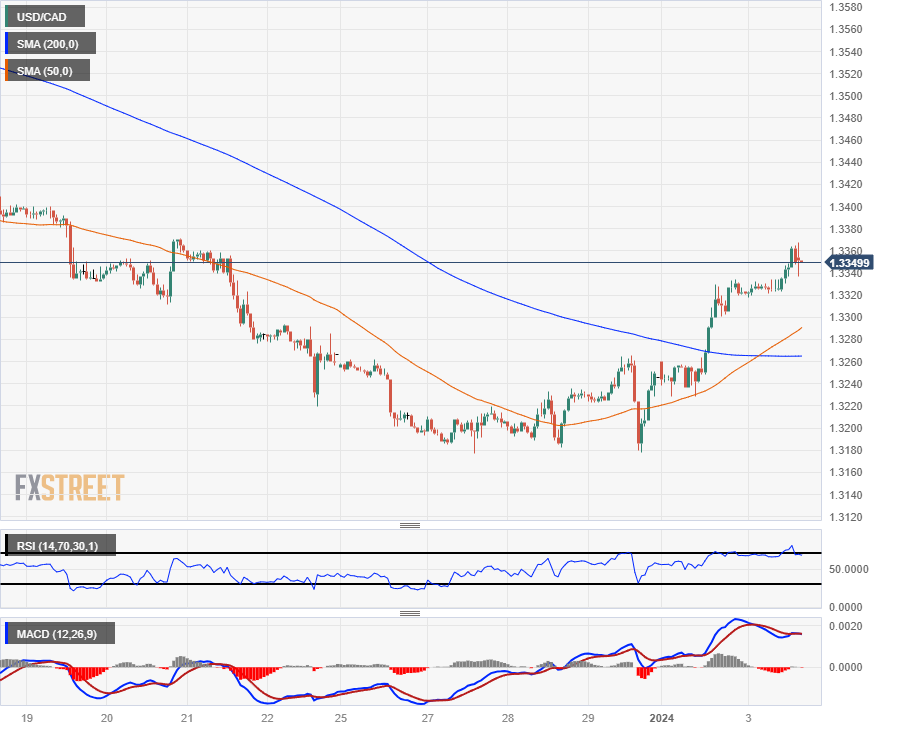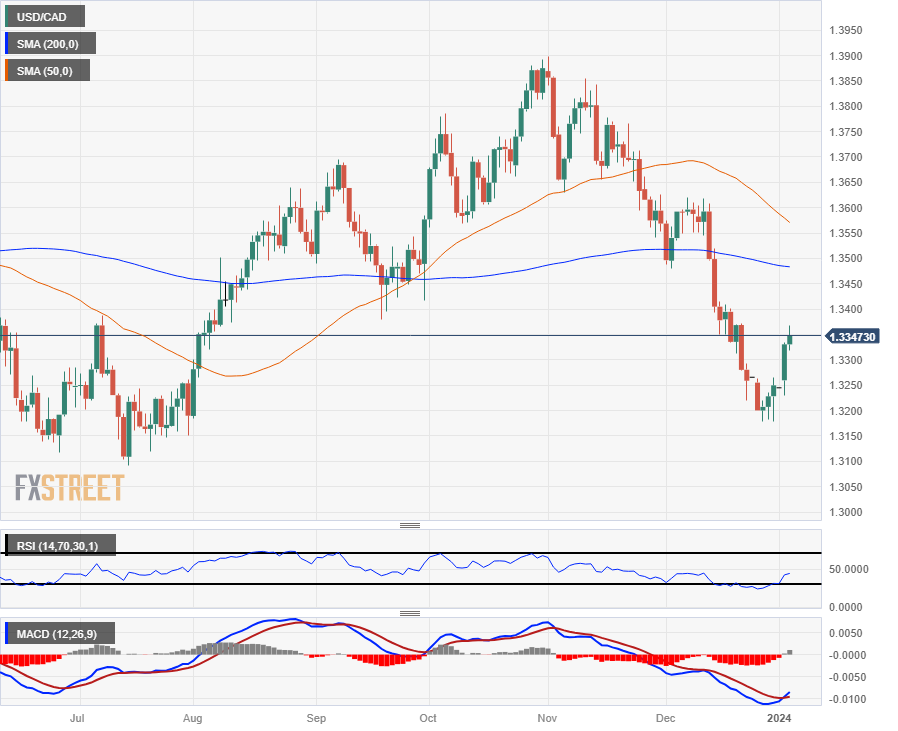Canadian Dollar extends losses against Greenback on US data prints
- Canadian Dollar slips further on Wednesday as US Dollar bids firm up.
- Canada economic data on hold until Friday, to be overshadowed by US NFP.
- US ISM PMI beat expectations but still on the contractionary side.
The Canadian Dollar (CAD) is falling for the fifth consecutive trading day against the US Dollar (USD), with the Greenback getting bolstered against the broader FX market after the US ISM Manufacturing Purchasing Managers’ Index (PMI) for December came in above expectations, despite still printing in contractionary territory below the 50.0 midline.
Economic data from Canada is once again absent from the data docket on Wednesday, and Friday’s Canadian Unemployment Rate and Average Hourly Wages are set to be entirely eclipsed by the US Nonfarm Payrolls (NFP) for December.
Daily digest market movers: Canadian Dollar giving up further ground amidst USD push
- Despite declines against the outperforming Greenback and Pound Sterling (GBP), the CAD is in a firm position against the rest of the majors.
- The Canadian Dollar is down around a fifth of a percent against the USD and a third of a percent against the GBP.
- The Aussie (AUD) has given up around 0.4% against the Loonie, while the Yen (JPY) has retreated nearly three-quarters of a percent against the Canadian Dollar.
- The US ISM Manufacturing PMI for December printed at 47.4, beating the market forecast of 47.1 and climbing over November’s print of 46.7.
- The US JOLTS Job Openings in November showed less hiring potential than expected, with 8.79 million jobs available versus the forecast 8.85 million. October’s JOLTS openings were also revised up slightly from 8.733 million to 8.852 million.
- Investors will note that JOLTS has a small sample size that leaves the data prone to volatility, as well as the published figures being subject to revision up to five years after publication.
- Wednesday’s key data release comes towards the end of the US trading session when the Federal Reserve (Fed) drops their latest meeting minutes at 19:00 GMT.
Canadian Dollar price today
The table below shows the percentage change of Canadian Dollar (CAD) against listed major currencies today. Canadian Dollar was the strongest against the Japanese Yen.
| USD | EUR | GBP | CAD | AUD | JPY | NZD | CHF | |
| USD | 0.31% | -0.12% | 0.20% | 0.70% | 0.92% | 0.25% | 0.29% | |
| EUR | -0.31% | -0.44% | -0.12% | 0.38% | 0.61% | -0.07% | -0.02% | |
| GBP | 0.12% | 0.44% | 0.32% | 0.82% | 1.04% | 0.37% | 0.41% | |
| CAD | -0.19% | 0.12% | -0.31% | 0.51% | 0.74% | 0.07% | 0.11% | |
| AUD | -0.70% | -0.36% | -0.82% | -0.50% | 0.24% | -0.45% | -0.40% | |
| JPY | -0.93% | -0.64% | -1.06% | -0.73% | -0.22% | -0.70% | -0.63% | |
| NZD | -0.26% | 0.06% | -0.37% | -0.05% | 0.44% | 0.68% | 0.05% | |
| CHF | -0.29% | 0.03% | -0.42% | -0.10% | 0.40% | 0.63% | -0.05% |
The heat map shows percentage changes of major currencies against each other. The base currency is picked from the left column, while the quote currency is picked from the top row. For example, if you pick the Euro from the left column and move along the horizontal line to the Japanese Yen, the percentage change displayed in the box will represent EUR (base)/JPY (quote).
Technical Analysis: Canadian Dollar heading for a fifth straight day of losses
The Canadian Dollar (CAD) is slipping back against the US Dollar, extending recent declines and driving the USD/CAD pair further above the 200-hour Simple Moving Average (SMA). The pair is set for a fresh challenge of the 1.3400 level, provided near-term action continues to catch support from the bullish crossover of the 50-hour and 200-hour SMAs near 1.3275.
Daily candlesticks have the USD/CAD extending a bullish correction into a fifth consecutive trading day, but the pair remains firmly below the 200-day SMA near 1.3500. Despite this, technical indicators are still recovering from getting pinned deep into oversold territory after the pair’s multi-week decline from November’s peak of 1.3899. Further room to run could be uncovered before the 50-day SMA manages to make a bearish cross of the 200-day SMA.
USD/CAD Hourly Chart

USD/CAD Daily Chart

Canadian Dollar FAQs
What key factors drive the Canadian Dollar?
The key factors driving the Canadian Dollar (CAD) are the level of interest rates set by the Bank of Canada (BoC), the price of Oil, Canada’s largest export, the health of its economy, inflation and the Trade Balance, which is the difference between the value of Canada’s exports versus its imports. Other factors include market sentiment – whether investors are taking on more risky assets (risk-on) or seeking safe-havens (risk-off) – with risk-on being CAD-positive. As its largest trading partner, the health of the US economy is also a key factor influencing the Canadian Dollar.
How do the decisions of the Bank of Canada impact the Canadian Dollar?
The Bank of Canada (BoC) has a significant influence on the Canadian Dollar by setting the level of interest rates that banks can lend to one another. This influences the level of interest rates for everyone. The main goal of the BoC is to maintain inflation at 1-3% by adjusting interest rates up or down. Relatively higher interest rates tend to be positive for the CAD. The Bank of Canada can also use quantitative easing and tightening to influence credit conditions, with the former CAD-negative and the latter CAD-positive.
How does the price of Oil impact the Canadian Dollar?
The price of Oil is a key factor impacting the value of the Canadian Dollar. Petroleum is Canada’s biggest export, so Oil price tends to have an immediate impact on the CAD value. Generally, if Oil price rises CAD also goes up, as aggregate demand for the currency increases. The opposite is the case if the price of Oil falls. Higher Oil prices also tend to result in a greater likelihood of a positive Trade Balance, which is also supportive of the CAD.
How does inflation data impact the value of the Canadian Dollar?
While inflation had always traditionally been thought of as a negative factor for a currency since it lowers the value of money, the opposite has actually been the case in modern times with the relaxation of cross-border capital controls. Higher inflation tends to lead central banks to put up interest rates which attracts more capital inflows from global investors seeking a lucrative place to keep their money. This increases demand for the local currency, which in Canada’s case is the Canadian Dollar.
How does economic data influence the value of the Canadian Dollar?
Macroeconomic data releases gauge the health of the economy and can have an impact on the Canadian Dollar. Indicators such as GDP, Manufacturing and Services PMIs, employment, and consumer sentiment surveys can all influence the direction of the CAD. A strong economy is good for the Canadian Dollar. Not only does it attract more foreign investment but it may encourage the Bank of Canada to put up interest rates, leading to a stronger currency. If economic data is weak, however, the CAD is likely to fall.

